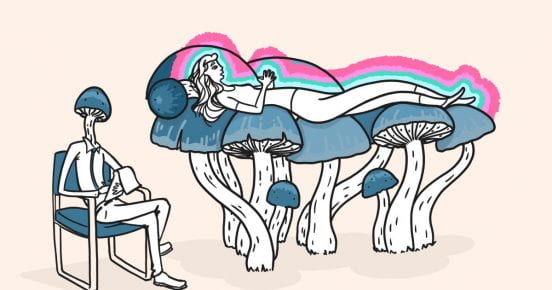In the past five decades, psychedelic substances have been explored for the treatment of mental health disorders, addiction, and for the enhancement of creativity and spiritual well-being. In this piece I will review the history and mechanisms of action of psychedelic substances, the resurgence of interest in their clinical applications, and the therapeutic mechanisms that may underlie their effects.
Psychedelic substances and their mechanisms of action
Psychedelics refers to compounds that elicit the perception of non-ordinary states of consciousness in the absence of sensory input. The classical psychedelic agents are lysergic acid diethylamide (LSD), psilocybin, mescaline, dimethyltryptamine (DMT), and 3,4-methylenedioxymethamphetamine (MDMA, ecstasy). These substances produce profound changes in perception, thought, emotion, and self-awareness. They are unique in that they typically produce psychedelic effects even when taken in the absence of sensory stimulation. In other words, they produce visual, auditory and other sensory phenomena in the absence of external stimuli. There are a number of non-classical drugs that have similar effects, including Salvia divinorum, a hallucinogenic plant that is legal in most countries.
The mechanisms of action of psychedelic agents are not completely understood, but appear to involve agonism of the serotonin-2A (5-HT 2A ) receptor in the central nervous system. Following ingestion, psychedelic agents are thought to enter the blood stream and cross the blood-brain barrier. The binding affinity of psychedelic agents for the 5-HT 2A receptor is significantly higher than for other receptors, including the 5-HT 2A receptor subtypes, and their partial agonist activity at the 5-HT 2A receptor has been proposed to be the mechanism for their efficacy in treating mental health disorders.
In clinical research settings around the world, renewed investigations are taking place on the use of psychedelic substances for treating illnesses such as addiction, depression, anxiety and post-traumatic stress disorder (PTSD). Since the termination of a period of research from the 1950s to the early 1970s, most psychedelic substances have been classified as “drugs of abuse” with no recognized medical value. However, controlled clinical studies have recently been conducted to assess the basic psychopharmacological properties and therapeutic efficacy of these drugs as adjuncts to existing psychotherapeutic approaches. The findings suggest that the psychedelic experience may be used in the treatment of mental health disorders and for the enhancement of spiritual well-being.
The history of psychedelic research
In the 1950s and 1960s, the use of psychedelic substances in psychospiritual explorations and as adjuncts to psychotherapy was widespread. In the early 1950s, the Swiss chemist Albert Hofmann discovered the hallucinogenic effects of LSD, and in 1953, received the first sample of LSD for medical purposes from the Sandoz pharmaceutical company in Basel, Switzerland. Hofmann had been investigating the medicinal use of lysergic acid as a circulatory and respiratory stimulant. After his discovery of the psychoactive properties of LSD, he conducted extensive experiments on himself and on his coworkers.
In the early 1950s, the US Central Intelligence Agency (CIA) initiated a research program on the use of LSD for chemical warfare, referred to as MK-ULTRA. The program was headed by Sidney Gottlieb and conducted experiments using LSD, other psychedelic substances, and various other methods for modifying the human psyche. The CIA also funded an extensive research program on LSD and other psychedelic substances at the New York State Psychiatric Institute at Columbia University. The program, known as Project MK-ULTRA, was headed by Harold A. Abramson, MD. In addition to its own research, the project provided LSD and other drugs for testing to a number of external researchers, including Hofmann.
In the early 1960s, Timothy Leary, Richard Alpert and Ralph Metzner began experimenting with LSD, psilocybin and other psychedelic substances at the Harvard Psilocybin Project, which was funded by the US National Institute of Mental Health (NIMH). At the same time, a research group at the University of California in Los Angeles (UCLA) led by Charles Savage was conducting similar experiments. Leary and colleagues began to popularize the use of psychedelic substances as a means of enhancing creativity and spiritual awareness. Their work received widespread publicity after a widely publicized Harvard symposium in 1962, and a series of articles in the popular press. Leary was dismissed from his position at Harvard University in 1963, and he and his colleagues were forced to leave the US in 1964. In 1967, Leary, Alpert and Metzner were fired from the University of California because of their continued public advocacy of psychedelic substances.
While working in Mexico in the 1960s, Hofmann discovered the hallucinogenic effects of the psilocybin mushrooms, and a group of researchers at the University of Kansas began to explore the use of psilocybin in psychotherapy. The group included Robert E. Mogar, MD, who conducted a series of experiments that demonstrated the efficacy of psilocybin in the treatment of alcohol abuse. In addition, there were many clinical studies of lysergic acid diethylamide (LSD) and other psychedelic substances.
While the initial clinical studies of psychedelic substances were promising, research was abruptly terminated in the early 1970s. The research was terminated because of the widespread use of psychedelic substances by the public and the subsequent passage of legislation in the United States (and other countries) that prohibited the use of psychedelic substances. The scheduling of psychedelic substances as “drugs of abuse” with no recognized medical use effectively halted research on their potential medical uses.
The modern revival of psychedelic research
In the 1990s, a renewed interest in the therapeutic potential of psychedelic substances emerged in the United States. This was related to the development of new methodologies for psychotherapy that have been labelled “Third Wave” approaches. The Third Wave approaches were a response to the “cognitive revolution” that occurred in the late 1970s and early 1980s, which emphasized the therapeutic power of the relationship between the clinician and patient as well as the importance of the patient’s unique experience of the therapeutic process. Third Wave approaches emphasized the use of a collaborative, non-directive style of encounter, and a focus on the patient’s “inner experience,” including the full range of feelings, perceptions and thoughts that are evoked. The Third Wave approaches are based on a paradigm that recognizes the importance of set (i.e., psychological expectations), setting (i.e., physical environment) and the therapeutic clinician–patient relationship as critical elements for facilitating healing experiences and realizing positive outcomes.
The fact that psychedelic substances can be powerful tools for healing when used in the context of psychotherapy was demonstrated in the late 1980s and early 1990s by two research groups. M.C. Mithoefer and colleagues conducted a clinical study in which patients with severe treatment-resistant PTSD were treated with MDMA, and the results were extremely encouraging. The findings were also confirmed by a research group from the Department of Psychiatry at the University of Zurich. In addition, both groups found that the therapeutic effects of MDMA were enhanced by pretreatment with a psychotherapy protocol that included preparatory and integrative post-session psychotherapy.
In 2000, the Multidisciplinary Association for Psychedelic Studies (MAPS) was founded to promote research of psychedelic substances in human subjects. MAPS has supported clinical trials with MDMA, LSD, psilocybin, and cannabis in patients with PTSD, cancer-related anxiety, and cluster headache. In addition, MAPS has sponsored a number of studies of psychological harm reduction with psychedelics in healthy volunteers. It is noteworthy that none of these studies reported any serious adverse reactions, which is remarkable given the doses of psychedelic substances that were administered.
The results of these clinical trials have led to a growing interest in the use of psychedelic substances in psychotherapy. This has been further fuelled by the publication of the results of a survey that was conducted in 2013 by the Johns Hopkins School of Medicine and published in the Journal of Psychopharmacology. The survey assessed the attitudes of psychiatrists and other physicians towards the use of psychedelic substances in psychotherapy and other medical applications. The results showed that most physicians were in favour of conducting clinical research with psychedelic substances and that there was strong interest in the use of these substances in psychiatric and medical applications.
The renewed interest in psychedelic research has also led to a call for new research into the therapeutic potential of psychedelic substances. This call has been endorsed by the American Psychological Association, which has called for the removal of the regulatory barriers that currently exist for conducting research with psychedelic substances.
The therapeutic potential of psychedelic substances for addiction treatment
A number of studies have already been conducted in which psychedelic substances were administered to subjects with various forms of addiction, including alcohol dependence, cocaine dependence, opioid dependence, and nicotine dependence. In general, the results of these studies have been promising, but, given the small sample sizes in these studies, further research is needed to confirm the results. In addition, it is important to note that some of the studies that have been conducted had methodological limitations, and some of the positive results might have been due to chance.
Although the results of these clinical trials have been encouraging, the findings have not yet been published in a peer-reviewed journal, and thus, conclusions about their therapeutic potential must be considered speculative. Furthermore, it is necessary to conduct controlled clinical trials with larger sample sizes and more rigorous methodology in order to obtain reliable results.
Conclusion
The results of the clinical trials that have been conducted so far show that the use of psychedelic substances in the context of psychotherapy can be safe and efficacious in treating various psychiatric disorders. However, larger, controlled clinical trials using more rigorous methodology are needed in order to obtain more reliable results. It is also important to note that psychedelics can be powerful tools for healing, but they are not a panacea. In the same way that psychedelics can be powerful tools for healing, they can also be powerful tools for doing harm, and thus, it is important to combine the use of psychedelics with psychotherapy in order to minimize the potential for abuse.
The use of psychedelics in this context is analogous to the use of psychoactive drugs in general. Precisely because psychoactive drugs are so powerful, they should not be used in the absence of a psychotherapeutic context. For instance, prescribing an opioid analgesic to a patient with severe chronic pain is a legitimate medical practice, whereas prescribing an opioid analgesic to a patient with mild chronic pain who does not have a serious underlying medical condition is not a legitimate medical practice. In the same way, administering a psychedelic substance to a patient with a psychiatric disorder is a legitimate medical practice, whereas administering a psychedelic substance to a healthy volunteer is not a legitimate medical practice outside the context of a controlled study.
With that said, psychedelics have real clinical potential and more research into their potential applications is desperately needed.






Comments by yang